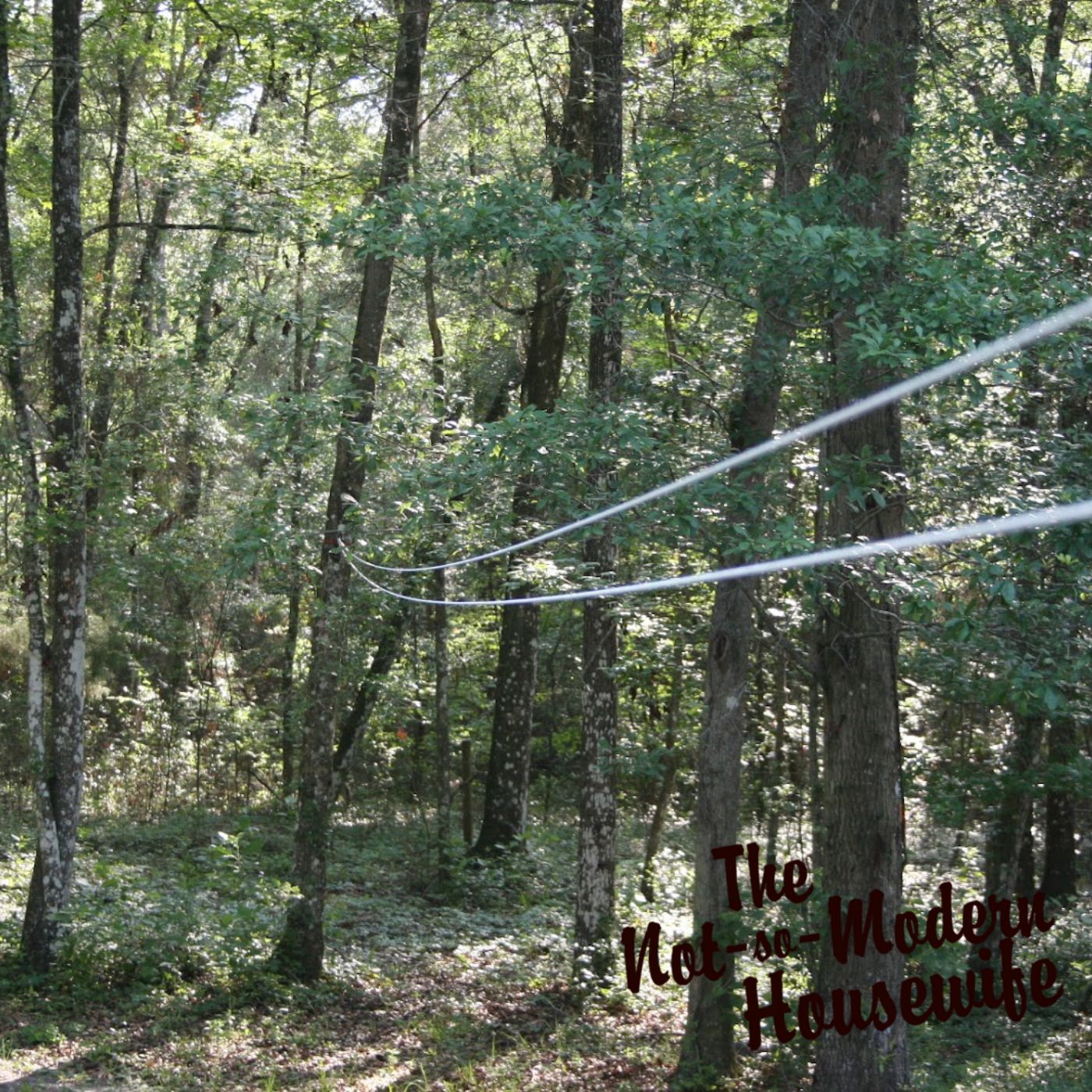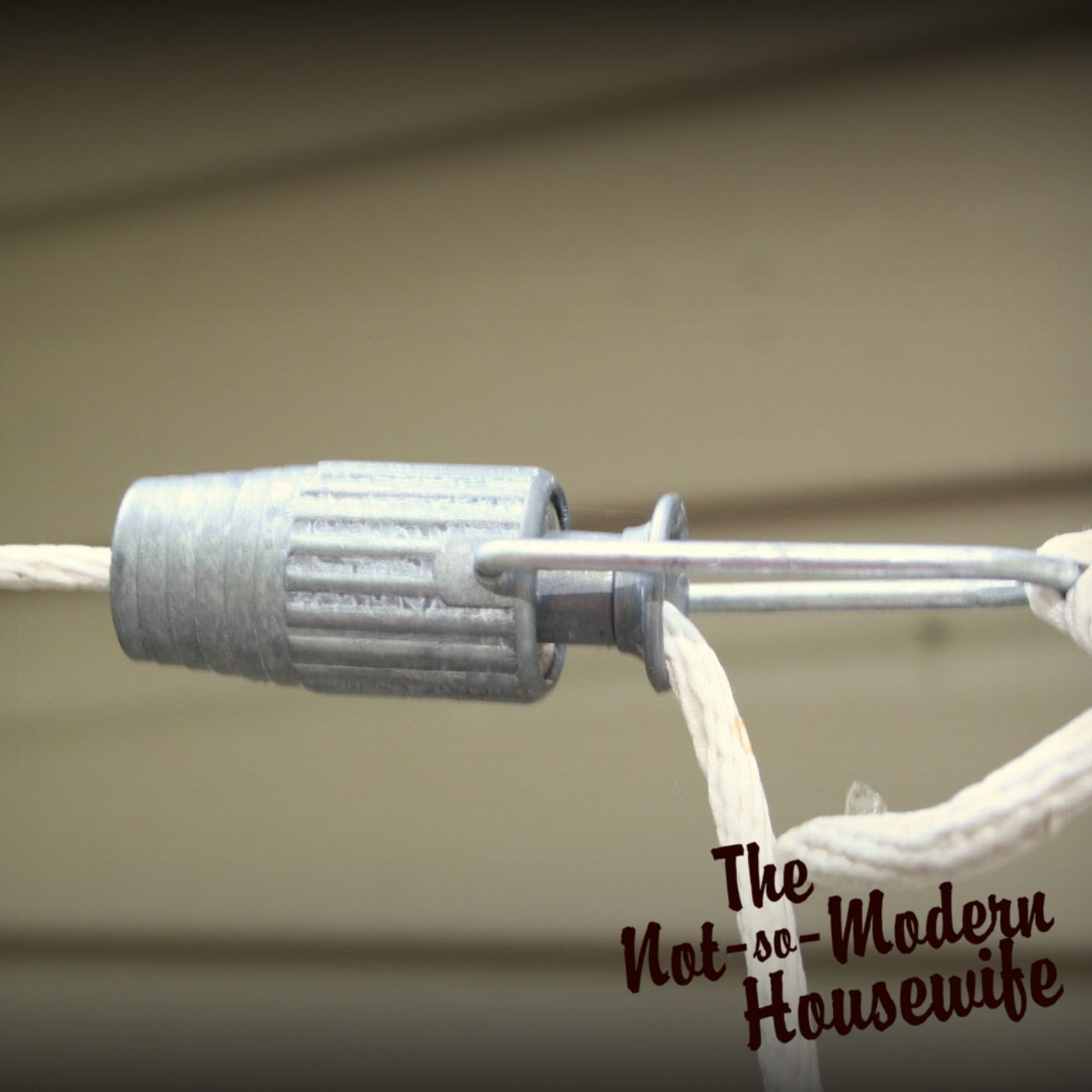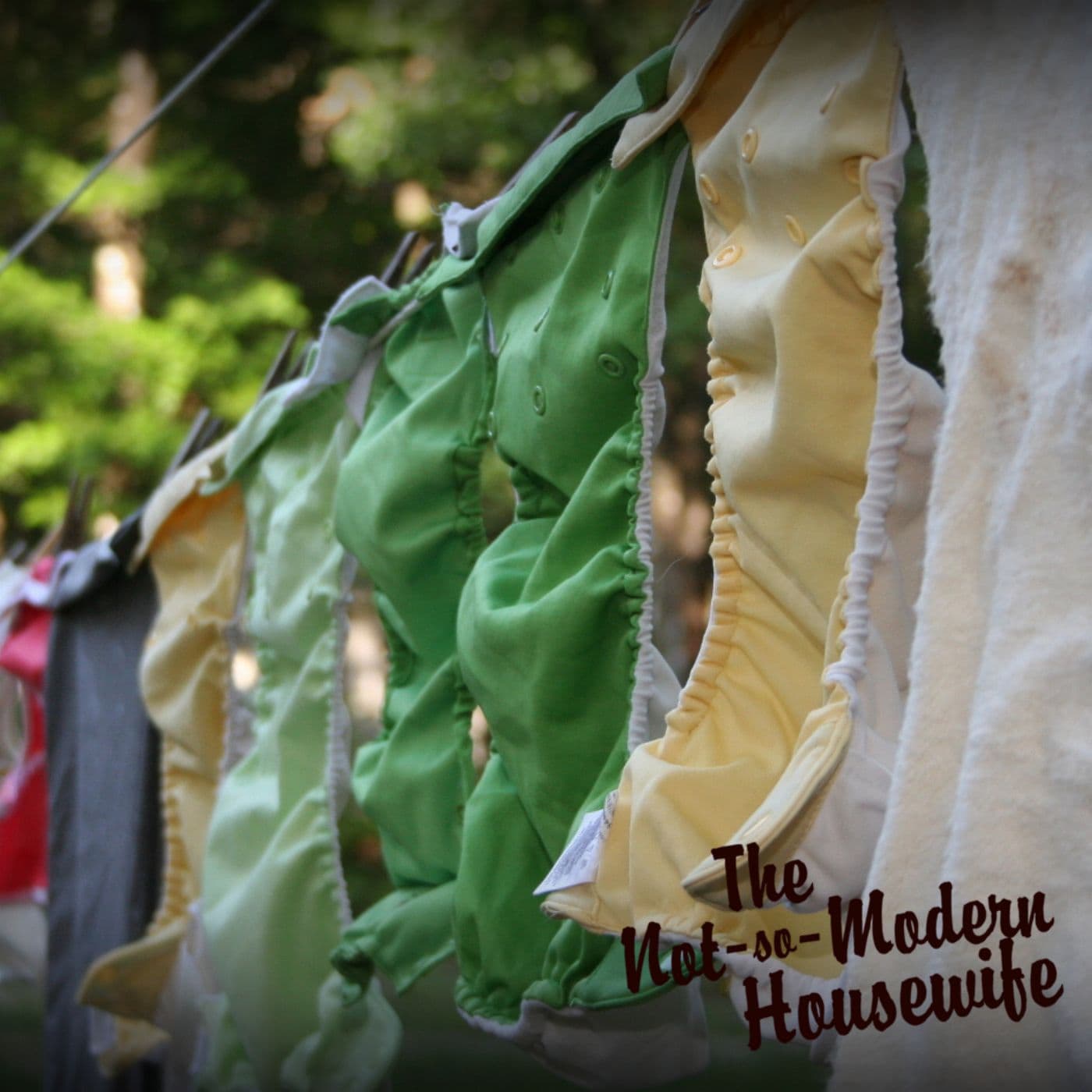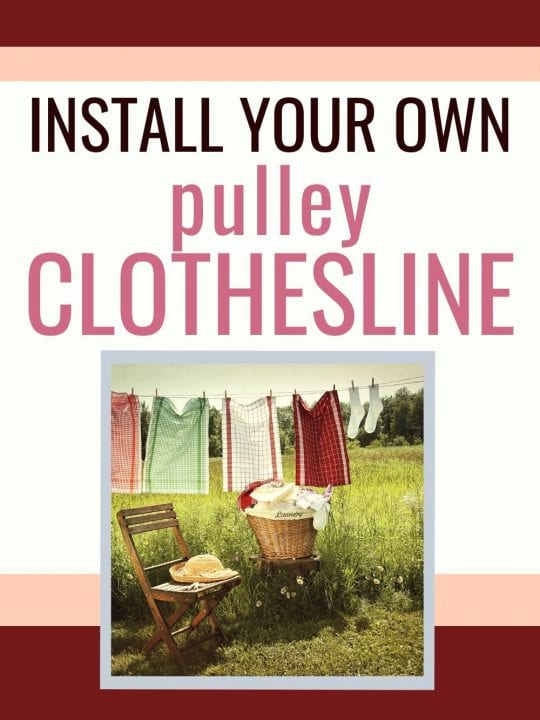Installing a pulley clothesline is a simple, effective way to dry laundry while reducing energy use, saving money on electricity, and extending the life of your fabrics. For me, it also carries a deep sense of nostalgia.
Growing up in Ohio, I watched my mom hang clothes on the clothesline outside our back door. One end of the line was attached to a pulley near the basement door, where the washer and dryer were located, and the other end ran through a pulley at the top of a light pole in the backyard. She dried our laundry outside in the summer and used a clothesline in the basement during the winter.
When I became a mom, I found myself drawn back to the idea of a clothesline. Unlike my childhood home, I don’t have a basement here in Florida, and our summers are often too rainy for effective outdoor drying. Instead, I get the most use out of my clothesline in the fall through spring when the weather is drier and more predictable. I first started using a clothesline when my oldest son was in cloth diapers as a way to cut down on our electric bill. Over time, I fell in love with the rhythm of hanging clothes outside, enjoying the simplicity and satisfaction of the process.
For many homemakers, especially those of us rooted in faith and homesteading, a pulley clothesline is more than just a laundry solution. It’s a way to steward our resources wisely, reduce our dependence on electricity, and connect with the natural rhythms of God’s creation. If you’ve been considering installing a pulley clothesline but aren’t sure where to start, this guide will walk you through everything you need to know.
Table of Contents

How Clotheslines Align with Christian Stewardship
As Christian homemakers, we are called to be good stewards of the blessings God has given us—including the earth. A pulley clothesline is a simple way to honor that responsibility.
- Energy-Efficient Laundry Solution – By line-drying our clothes, we cut down on electricity use and reduce our carbon footprint.
- Embracing Simple Living – A clothesline encourages us to slow down, appreciate our labor, and find joy in everyday tasks.
- Teaching Stewardship to Our Children – Inviting our children to help with laundry teaches them valuable life skills and the importance of caring for what we own.
Now, let’s get into the practical side of installing your pulley clothesline.

7 Easy Steps to Install a Clothesline with Pulleys: A Homesteader’s Guide
1. Gathering Your Materials: What You’ll Need
For a reliable 100 ft pulley clothesline setup, here’s what I recommend:
- 2 Steal Screw Hooks – Amazon | Home Depot
- 4″ Clothesline Pulley – Amazon | Home Depot
- 200′ Braided Cotton Clothesline Rope – Amazon | Home Depot
- 1 Clothesline Tightener – Amazon | Home Depot
- 100 Clothespins – Amazon | Home Depot
- 5-6 Clothesline Separators – Amazon | Home Depot
2. Choosing the Perfect Location: Sun, Space, and Serenity
The best placement for your clothesline is a sunny, breezy area with plenty of airflow. Consider these factors:
- Sunlight exposure – Direct sun helps dry clothes faster and naturally disinfects them.
- Distance between anchor points – The standard length is 25-50 feet, but with a 200 ft clothesline rope, you can accommodate longer setups. My personal clothesline is closer to 75 feet, which allows for a balance of space and functionality.
- Convenience – Hang the line at a height that allows for easy access.
3. Installing the Pulleys
- Secure one pulley to a high anchor point (tree, post, or wall bracket).
- Attach the second pulley at the opposite anchor point. The pulley where you hang clothes is often positioned lower for easy access while maintaining a similar height from the ground. For example, my house pulley is above my deck, making it just above my head when I stand on the deck, so I can easily reach it without stretching.
- Use heavy-duty screws or bolts to keep the pulleys secure.
4. Threading the Clothesline
- Feed the rope through both pulleys, forming a continuous loop.
- Pull the rope taut to prevent sagging but leave enough flexibility for movement.

5. Installing a Clothesline Tightener
- Tie the bottom rope of the clothesline to the metal loop on one end of the tightener. This is the end of the rope leading to the far pulley.
- Take the other end of the clothesline—the part coming from the nearest pulley—and feed it through the ball bearings inside the tightener.
- Pull the rope through the tightener until the line is taut.
- The tightener will hold the rope in place, allowing for easy adjustments as the clothesline stretches over time.
- Once the desired tension is achieved, trim off any excess clothesline to maintain a neat and functional setup.
6. Using Clothesline Separators to Prevent Sagging
- Attach clothesline separators at even intervals along the length of the line.
- These separators secure the bottom rope to the top rope, preventing sagging when laundry is hung.
- Ensure they are spaced out to support the weight of wet clothing effectively.
7. Testing Your Clothesline
- Hang a few items to ensure the line moves smoothly.
- Adjust tension as needed.
- Enjoy the simplicity of sun-dried laundry!
How to Install a Clothesline with Pulleys
Stay organized and make installing and maintaining your pulley clothesline simple with this printable to-do list! Whether you're setting up a new DIY outdoor clothesline system or keeping your existing one in top shape, this checklist ensures you don’t miss a step.
Materials
- 2 Steal Screw Hooks
- 4″ Clothesline Pulley
- 200′ Braided Cotton Clothesline
- 1 Clothesline Tightener
- 100 Clothespins
- 5-6 Clothesline Separators
Tools
- Electric Drill
- Ladder
- Long Screwdriver
Instructions
? Installation Steps
?? Gather materials: pulleys, screw hooks, clothesline rope, tightener, separators, and clothespins.
?? Choose a location with good airflow and sunlight.
?? Secure pulleys to sturdy anchor points (house, tree, or post).
?? Thread the clothesline through both pulleys, creating a continuous loop.
?? Attach the clothesline tightener between the nearest pulley and anchor point.
?? Use clothesline separators to prevent sagging.
?? Adjust tension and trim excess rope.
?? Test by hanging a few items to ensure smooth movement.
? Maintenance & Seasonal Care
?? Check for rope wear and pulley movement monthly.
?? Retighten the line using the clothesline tightener as needed.
?? Clean pulleys and hooks to prevent dirt buildup.
?? Use clothesline separators to maintain even spacing.
?? Store clothespins indoors to extend their lifespan.
?? Adjust laundry timing in rainy or humid seasons for best drying results.
? Laundry Routine Tips
?? Shake out clothes before hanging to reduce stiffness and wrinkles.
?? Space items for maximum airflow and quicker drying.
?? Use white vinegar in the rinse cycle to soften fabric naturally.
?? Bring laundry in promptly to prevent overexposure to sun fading.
?? If needed, toss air-dried clothes in the dryer for 5 minutes to fluff.
Recommended Products
As an Amazon Associate and member of other affiliate programs, I earn from qualifying purchases.
Common Questions About Pulley Clotheslines
Will screwing a hook into a tree damage it?
If installed properly, screwing a hook into a tree will not cause significant harm. However, to minimize damage:
- Use a stainless steel or galvanized hook to prevent rust and tree infection. For best results, install the hook into the trunk rather than a branch to provide better support and minimize stress on the tree.
- Choose a mature, healthy tree with a strong trunk.
- Avoid over-tightening, which could cut into the bark and hinder growth.
- Periodically check for signs of stress and adjust as needed.
Where do you put the tightener so that it doesn’t get trapped by line separators or pulleys?
The clothesline tightener should be installed on the lower section of the line between the nearest pulley and the anchor point (such as a post or tree). This placement keeps it accessible for adjustments while ensuring it doesn’t get trapped by line separators or obstruct the pulleys. When tensioning the line, slide the tightener toward the anchor point until the desired tautness is achieved. Placing it here ensures that:
- It remains accessible for adjustments.
- It does not interfere with the movement of the clothesline.
- It does not get stuck against line separators or pulleys.
What is a line separator?
A line separator is a small plastic or metal device that connects the top and bottom sections of the clothesline, keeping them evenly spaced apart. This helps:
- Prevent the bottom rope from sagging under the weight of wet laundry.
- Ensure clothes dry evenly by maintaining airflow between layers.
- Keep the line stable in windy conditions.
Is there a risk of a heavy line pulling from the house and making holes or worse?
Yes, a heavily loaded clothesline can create strain on its anchor points. To prevent damage:
- Secure the hook into a wall stud or a reinforced structure rather than just siding.
- Use a heavy-duty clothesline hook or bracket rated for outdoor use.
- Avoid overloading the line with too much wet laundry at once.
- Regularly inspect for wear and tear, tightening hardware as needed.
What is a clothesline tension adjuster?
A clothesline tension adjuster is a device—such as a clothesline tightener with ball bearings—that helps maintain proper tension in the line as it stretches over time. It allows for easy adjustments without needing to untie and retie knots. This keeps the line functional and prevents sagging, ensuring your laundry dries efficiently.
- Hang a few items to ensure the line moves smoothly.
- Adjust tension as needed.
- Enjoy the simplicity of sun-dried laundry!

How to Prevent and Soften Stiff Laundry
One common concern with line-drying clothes is that they can become stiff, especially towels and jeans. Here are some tips to keep your laundry feeling soft and comfortable:
- Use White Vinegar as a Fabric Softener – Add ½ cup of white vinegar to the rinse cycle to naturally soften fabrics and remove detergent residue.
- Shake Out Clothes Before Hanging – Give each item a good shake before pinning it to the line to reduce stiffness and wrinkles.
- Hang Clothes with Airflow in Mind – Space items apart to allow for maximum airflow, which helps prevent fabric from becoming too rigid.
- Use the Wind to Your Advantage – A breezy day can help soften clothes naturally as they dry.
- Tumble Dry for a Few Minutes – If possible, toss stiff clothes in the dryer for 5-10 minutes on low heat with a damp washcloth to fluff them up.
- Choose the Right Detergent – A detergent with fewer fillers and residue-producing agents can help clothes stay softer after line drying.
Clothesline Installation: A Family Project for Christian Homemakers
Teaching Children the Value of Hard Work and Simplicity
Installing and using a clothesline is a wonderful opportunity to involve your children in a meaningful household task. Assign them age-appropriate roles, such as handing you clothespins or helping fold dry clothes.
Turning Chores into Blessings: A Spiritual Perspective
Chores don’t have to be mundane. They can be a way to practice gratitude and mindfulness. As I hang each piece of laundry, I find it to be a meditative time, free from distractions. It gives me space to reflect on my many blessings, appreciate the quiet moments, and embrace the simple rhythms of home life. The act of hanging clothes allows me to slow down, breathe in the fresh air, and find peace in the everyday tasks of homemaking.
Final Thoughts
A pulley clothesline isn’t just a practical homesteading tool—it’s a symbol of intentional living, stewardship, and the joy of embracing simple routines. Whether you’re new to homesteading or looking for ways to slow down and reconnect with your home, installing a clothesline can be a small yet powerful step.
Have you installed a pulley clothesline on your homestead? I’d love to hear your experiences and tips in the comments below! And if you’re looking for more homesteading and homemaking wisdom, be sure to subscribe to my newsletter for practical advice and inspiration straight to your inbox.
Pin this article for later:






